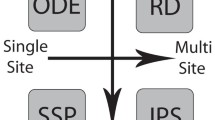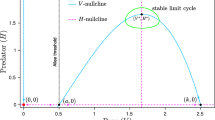Abstract
Spatial patterns are ubiquitous in nature, which have been identified as important factors in dynamics of ecosystems. However, how pattern structures have influence on persistence of populations is far from well being understood. Particularly, whether some characters of spatial pattern can be indicators for ecosystems collapse is not well studied. As a result, we presented a predator–prey system with spatial motion and found that isolation degree (average distance between patterns with high density) of spatial patterns plays an important role in the persistence of populations: If isolation degree is much smaller, then the population will persist; if isolation degree is much larger, then the population density will decrease with increasing space size and run a high risk of extinction as space size is large enough. Our results highlight the relationship between pattern structures and ecosystems collapse.





Similar content being viewed by others
Notes
Since this critical value depends on the parameters sets and the lattice size, it can not be expressed mathematically.
References
Murray, J.D.: Mathematical Biology II: Spatial Models and Biomedical Applications. Springer, New York (2003)
Nowak, M.A., May, R.M.: Evolutionary games and spatial chaos. J. Anim. Ecol. 359, 826–829 (1992)
Segel, L., Jackson, J.: Dissipative structure: an explanation and an ecological example. J. Theor. Biol. 37, 545–559 (1972)
Comins, H.N., Hassell, M.P., May, R.M.: The spatial dynamics of host-parasitoid systems. J. Anim. Ecol. 61, 735–748 (1992)
Turing, A.M.: The chemical basis of morphogenesis. Philos. Trans. R. Soc. Lond. B 237, 37–72 (1952)
Medvinsky, A.B., Petrovskii, S.V., Tikhonova, I.A., Malchow, H., Li, B.-L.: Spatio-temporal complexity of plankton and fish dynamics in simple model ecosystems. SIAM Rev. 44, 311–370 (2002)
Sherratt, J.A.: Unstable wavetrains and chaotic wakes in reaction–diffusion systems of lambda-omega type. Phys. D 82, 165–179 (1995)
Sherratt, J.A., Lambin, X., Sherratt, T.N.: The effects of the size and shape of landscape features on the formation of traveling waves in cyclic populations. Am. Nat. 162, 503–513 (2003)
Sherratt, J.A., Lambin, X., Thomas, C.J., Sherratt, T.N.: Generation of periodic waves by landscape features in cyclic predator–prey systems. Proc. R. Soc. Lond. B 269, 327–334 (2002)
Chen, J.-X., Peng, L., Zheng, Q., Zhao, Y.-H., Ying, H.-P.: Influences of periodic mechanical deformation on pinned spiral waves. Chaos 24, 033103 (2014)
Chen, J.-X., Peng, L., Ma, J., Ying, H.-P.: Liberation of a pinned spiral wave by a rotating electric pulse. EPL 107, 38001 (2014)
Lou, Q., Chen, J.-X., Zhao, Y.-H., Shen, F.-R., Fu, Y., Wang, L.-L., Liu, Y.: Control of turbulence in heterogeneous excitable media. Phys. Rev. E 85, 026213 (2012)
Petrovskii, S., Li, B.L., Malchow, H.: Quantification of the spatial aspect of chaotic dynamics in biological and chemical systems. Bull. Math. Biol. 65, 425–446 (2003)
Morozov, A., Petrovskii, S., Li, B.L.: Bifurcations and chaos in a predator–prey system with the Allee effect. Proc. R. Soc. Lond. B 271, 1407–1414 (2004)
Alonso, D., Bartumeus, F., Catalan, J.: Mutual interference between predators can give rise to Turing spatial patterns. Ecology 83, 28–34 (2002)
Baurmann, M., Gross, T., Feudel, U.: Instabilities in spatially extended predator-prey systems: spatiotemporal patterns in the neighborhood of Turing–Hopf bifurcations. J. Theor. Biol. 245, 220–229 (2007)
Garvie, M.R.: Finite-difference schemes for reaction–diffusion equations modeling predator–prey interactions in Matlab. Bull. Math. Biol. 69, 931–956 (2007)
Gurney, W.S.C., Veitch, A.R., Cruickshank, I., Mcgeachin, G.: Circles and spirals: population persistence in a spatially explicit predator–prey model. Ecology 79, 2516–2530 (1998)
Hengeveld, R.: Dynamics of Biological Invasions. Chapman and Hall, London (1989)
Li, Z.-Z., Gao, M., Hui, C., Han, X.-Z., Shi, H.: Impact of predator pursuit and prey evasion on synchrony and spatial patterns in metapopulation. Ecol. Model. 185, 245–254 (2005)
Malchow, H.: Motional instabilities in predator–prey systems. J. Theor. Biol. 204, 639–647 (2000)
Wu, X., Ma, J., Yuan, L., Liu, Y.: Simulating electric activities of neurons by using PSPICE. Nonlinear Dyn. 75, 113–126 (2013)
Ma, J., Liu, Q., Ying, H., Wu, Y.: Emergence of spiral wave induced by defects block. Commun. Nonlinear Sci. Numer. Simul. 18, 1665–1675 (2013)
Liu, T.-B., Ma, J., Zhao, Q., Tang, J.: Force exerted on the spiral tip by the heterogeneity in an excitable medium. EPL 104, 58005 (2013)
Ma, J., Wu, X., Chu, R., Zhang, L.: Selection of multi-scroll attractors in Jerk circuits and their verification using Pspice. Nonlinear Dyn. 76, 1951–1962 (2014)
Ma, J., Wang, C.N., Jin, W.Y., Wu, Y.: Transition from spiral wave to target wave and other coherent structures in the networks of Hodgkin–Huxley neurons. Appl. Math. Comput. 217, 3844–3852 (2010)
Panfilov, A.V., Muller, S.C., Zykov, V.S., Keener, J.P.: Elimination of spiral waves in cardiac tissue by multiple electrical shocks. Phys. Rev. E 21, 4644–4647 (2000)
Fenton, F.H., Cherry, E.M., Hastings, H.M., Evans, S.J.: Multiple mechanisms of spiral wave breakup in a model of cardiac electrical activity. Chaos 12, 852 (2002)
Quail, T., Shrier, A., Glass, L.: Spatial symmetry breaking determines spiral wave chirality. Phys. Rev. Lett. 113, 158101 (2014)
Hou, Z., Yang, L., Zuo, X., Xin, H.: Noise induced pattern transition and spatiotemporal stochastic resonance. Phys. Rev. Lett. 81, 2854–2857 (1998)
Lindner, B., Garcia-Ojalvo, J., Neiman, A., Schimansky-Geier, L.: Effects of noise in excitable systems. Phys. Rep. 392, 321–424 (2004)
Ciarletta, P., Balbi, V., Kuhl, E.: Pattern selection in growing tubular tissues. Phys. Rev. Lett. 113, 248101 (2014)
Fernandes, L.D., de Aguiar, M.A.M.: Turing patterns and apparent competition in predator–prey food webs on networks. Phys. Rev. E 86, 056203 (2012)
Rodrigues, L.A.D., Mistro, D.C., Petrovskii, S.: Pattern formation, long-term transients, and the Turing–Hopf bifurcation in a space-and time-discrete predator–prey system. Bull. Math. Biol. 73, 1812–1840 (2010)
Sun, G.-Q., Zhang, G., Jin, Z., Li, L.: Predator cannibalism can give rise to regular spatial pattern in a predator–prey system. Nonlinear Dyn. 58, 75–84 (2009)
Sun, G.-Q., Jin, Z., Li, L., Haque, M., Li, B.-L.: Spatial patterns of a predator–prey model with cross diffusion. Nonlinear Dyn. 69, 1631–1638 (2012)
Sun, G.-Q., Jin, Z., Liu, Q.-X., Li, L.: Dynamical complexity of a spatial predator–prey model with migration. Ecol. Model. 219, 248–255 (2009)
Zhang, L., Thygesen, U., Banerjee, M.: Size-dependent diffusion promotes the emergence of spatiotemporal patterns. Phys. Rev. E 90, 012904 (2014)
Kefi, S., Rietkerk, M., Alados, C.L., Pueyo, Y., Papanastasis, V.P., ElAich, A., de Ruiter, P.C.: Spatial vegetation patterns and imminent desertification in Mediterranean arid ecosystems. Nature 449, 213–217 (2007)
Scheffer, M., Bascompte, J., Brock, W.A., Brovkin, V., Carpenter, S.R., Dakos, V., Held, H., van Nes, E.H., Rietkerk, M., Sugihara, G.: Early-warning signals for critical transitions. Nature 461, 53–59 (2009)
Wang, M.X.: Stationary patterns for a prey–predator model with prey-dependent and ratio-dependent functional responses and diffusion. Phys. D 196, 172–192 (2004)
Peng, R., Shi, J.P., Wang, M.X.: Stationary pattern of a ratio-dependent food chain model with diffusion. SIAM J. Appl. Math. 67, 1479–1503 (2007)
Yochelis, A., Tintut, Y., Demer, L.L., Garfinkel, A.: The formation of labyrinths, spots and stripe patterns in a biochemical approach to cardiovascular calcification. New J. Phys. 10, 055002 (2008)
Rietkerk, M., van de Koppel, J.: The formation of labyrinths, spots and stripe patterns in a biochemical approach to cardiovascular calcification. Trends Ecol. Evol. 23, 169–175 (2008)
Cross, M.C., Hohenberg, P.C.: Pattern formation outside of equilibrium. Rev. Mod. Phys. 65, 851–1112 (1993)
Acknowledgments
The project is funded by the National Natural Science Foundation of China under Grants (11171314, 11331009, 31500443, 11501338 and 11301490), and International Exchange Program of Postdoctor in Fudan University.
Author information
Authors and Affiliations
Corresponding author
Appendices
Appendix 1: Derivation of Laplacian operator
We want to demonstrate that if an individual moves randomly in the space, then Laplacian operator can describe such motion. We firstly show the derivation of Laplacian operator in one-dimensional space. Random walk assumes that an individual takes steps of length \(\triangle x\) to its left or right side along a line, and after each \(\triangle t\) time unit, the individual will take one step. Initially, the individual locates at \(x_0\) at initial time \(t_0\), then after one step, the individual will locate at either \(x_0-\triangle x\) or \(x_0+\triangle x\) at time \(t_0+\triangle t\) with the same probability 1 / 2 (see Fig. 6). Denote P(t, x) as the number (or density) of individuals at time t and location x. Then, we have
Taylor expansion gives rise to:
which induces that:
Since \(\triangle t\) and \(\triangle x\) are small enough, the higher-order terms are very close to zero. As a result, one can have:
With the assumption that:
we obtain that:
The derivation in two-dimensional space is the same with that in one-dimensional space.
Appendix 2: Conditions of Turing pattern in system (2.3)
The Jacobian matrix corresponding to the equilibrium point \(E^*\) is that
We address the temporal stability of the uniform states which is associated with non-uniform perturbations
where \(\lambda \) is the perturbation growth rate, \(\kappa \) is the wavenumber, and c.c. stands for complex conjugate. The linear instability \((\theta \ll 1)\) of each one of the uniform states, is deduced from the dispersion relations. Substituting expression (5.7) into system (2.3) and neglecting all nonlinear terms in u and v, one finds the characteristic equation for the growth rate \(\lambda \) as \(\mathrm{det}(J)\), where
As a result, the corresponding eigenvalues are
where
Consequently, the conditions of Turing pattern in system (2.3) are \(\mathrm Re(\lambda _{\kappa =0})<0 \) and \(\mathrm Re(\lambda _{\kappa >0})>0\) for some \(\kappa >0\).
Rights and permissions
About this article
Cite this article
Sun, GQ., Wu, ZY., Wang, Z. et al. Influence of isolation degree of spatial patterns on persistence of populations. Nonlinear Dyn 83, 811–819 (2016). https://doi.org/10.1007/s11071-015-2369-6
Received:
Accepted:
Published:
Issue Date:
DOI: https://doi.org/10.1007/s11071-015-2369-6





